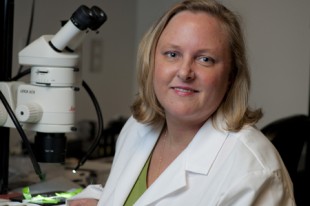David Ruth
713-348-6327
david@rice.edu
Jade Boyd
713-348-6778
jadeboyd@rice.edu
Designing a better way to study stomach flu
Texas Medical Center team aims to improve research of gastrointestinal disease
HOUSTON — (March 16, 2015) — Rice University bioengineers are teaming with colleagues from Baylor College of Medicine and MD Anderson Cancer Center to apply the latest techniques in tissue engineering toward the study of one of the most common and deadly human illnesses — the stomach flu.
The bacteria and viruses that cause acute gastroenteritis often come from contaminated food or water and result in cramps, nausea, diarrhea and vomiting. In medical terms, these pathogens fall under the heading of “human enteric disease,” and while they may be common, they can also be deadly. Diarrheal diseases still account for about 17 percent of worldwide human deaths each year, and they are the second-leading killer of children 5 and younger.
One roadblock to studying enteric pathogens like human rotaviruses and E. coli is that the organisms behave differently in humans than they do in animals typically used in medical research. Stem cell research has led to recent breakthroughs in the development of more realistic cell culture models, but there’s room for improvement.
“Infectious-disease labs that study enteric disease need better models that faithfully simulate the physiology of the intestine,” Rice tissue engineering researcher Jane Grande-Allen, the Isabel C. Cameron Professor of Bioengineering. “This organ contains multiple types of cells that are arranged in complex patterns, and these tissues are constantly on the move. They contract and expand all the time, and we suspect some pathogens take advantage of that motion to mount their attacks.”
Thanks to a $5.1 million grant from the National Institutes of Health, Grande-Allen and colleagues at Baylor and MD Anderson are embarking on a five-year program to create a bioreactor that more closely simulates the complex tissues and dynamic movements of the intestinal tract.
“This kind of problem can only be solved with teamwork because it requires expertise in enteric disease, cell biology, tissue engineering, bioreactor design and more,” said Baylor’s Mary Estes, the Cullen Chair of Molecular and Human Virology and principal investigator on the grant from the National Institute of Allergy and Infectious Diseases. “No single institution has all of that expertise, but thanks to the resources in the Texas Medical Center, we have assembled a team that is uniquely qualified to meet this challenge.”
Grande-Allen’s lab will work with Baylor’s Mary Dickinson, the Morrow Chair in Molecular Physiology and Biophysics, to create a platform that will allow cultures to be mechanically stimulated and that will promote cell differentiation and tissue patterning. Other research teams will work on creating enteroid cultures, tests involving infectious pathogens and identifying commensal gut bacteria, or probiotics, that may help fend off common pathogens like rotavirus and E. coli.
Grande-Allen said the team’s five-year goal is to deliver a simple, easy-to-use and relatively inexpensive system that could be easily implemented by any infectious disease lab.
Other members of the research team include, from Baylor, Sarah Blutt, Anthony Maresso, Joseph Petrosino and Noah Shroyer and, from MD Anderson, Pablo Okhuysen.
-30-
High-resolution IMAGES are available for download at:
https://news2.rice.edu/files/2015/03/0316_NIH-GrandeAllen-lg.jpg
CAPTION: Jane Grande-Allen
CREDIT: Jeff Fitlow/Rice University
Located on a 300-acre forested campus in Houston, Rice University is consistently ranked among the nation’s top 20 universities by U.S. News & World Report. Rice has highly respected schools of Architecture, Business, Continuing Studies, Engineering, Humanities, Music, Natural Sciences and Social Sciences and is home to the Baker Institute for Public Policy. With 3,920 undergraduates and 2,567 graduate students, Rice’s undergraduate student-to-faculty ratio is just over 6-to-1. Its residential college system builds close-knit communities and lifelong friendships, just one reason why Rice is highly ranked for best quality of life by the Princeton Review and for best value among private universities by Kiplinger’s Personal Finance. To read “What they’re saying about Rice,” go here.


